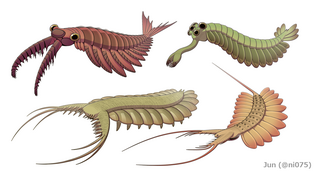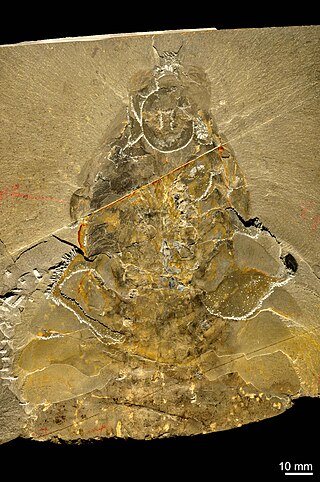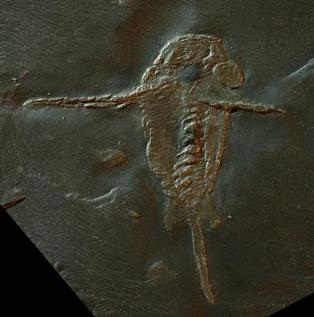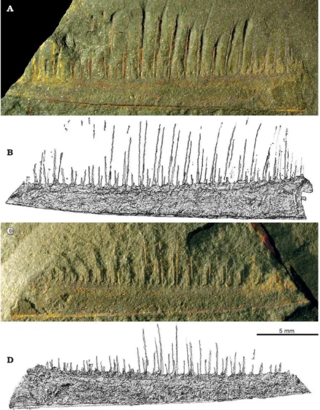
Dinocaridida is a proposed fossil taxon of basal arthropods, which flourished during the Cambrian period and survived up to Early Devonian. Characterized by a pair of frontal appendages and series of body flaps, the name of Dinocaridids refers to the suggested role of some of these members as the largest marine predators of their time. Dinocaridids are occasionally referred to as the 'AOPK group' by some literatures, as the group compose of Radiodonta, Opabiniidae, and the "gilled lobopodians" Pambdelurion and Kerygmachelidae. It is most likely paraphyletic, with Kerygmachelidae and Pambdelurion more basal than the clade compose of Opabiniidae, Radiodonta and other arthropods.

Anomalocaris is an extinct genus of radiodont, an order of early-diverging stem-group marine arthropods.

Peytoia is a genus of hurdiid radiodont, an early diverging order of stem-group arthropods, that lived in the Cambrian period, containing two species, Peytoia nathorsti from the Miaolingian of Canada and Peytoia infercambriensis from Poland, dating to Cambrian Stage 3. Its two frontal appendages had long bristle-like spines, it had no fan tail, and its short stalked eyes were behind its large head.

Anomalocarididae is an extinct family of Cambrian radiodonts, a group of stem-group arthropods.

Schinderhannes bartelsi is a species of hurdiid radiodont (anomalocaridid), known from one specimen from the Lower Devonian Hunsrück Slates. Its discovery was astonishing because the latest definitive radiodonts were known only from the Early Ordovician, at least 66 million years earlier than this taxon.

Radiodonta is an extinct order of stem-group arthropods that was successful worldwide during the Cambrian period. Radiodonts are distinguished by their distinctive frontal appendages, which are morphologically diverse and were used for a variety of functions. Radiodonts were among the earliest large predators, but they also included sediment sifters and filter feeders. Some of the most famous species of radiodonts are the Cambrian taxa Anomalocaris canadensis, Hurdia victoria, Peytoia nathorsti, Titanokorys gainesi, Cambroraster falcatus and Amplectobelua symbrachiata. The later surviving members include the subfamily Aegirocassisinae from the Early Ordovician of Morocco and the Early Devonian member Schinderhannes bartelsi from Germany.

Hurdia is an extinct genus of hurdiid radiodont that lived 505 million years ago during the Cambrian Period. Fossils have been found in North America, China and the Czech Republic.

Stanleycaris is an extinct genus of hurdiid radiodont from the Cambrian. The type species is Stanleycaris hirpex. Stanleycaris was described from the Stephen Formation near the Stanley Glacier and Burgess Shale locality of Canada, as well as Wheeler Formation of United States. A second species, S. qingjiangensis is known from the Qingjiang biota of China. The genus was characterized by the rake-like frontal appendages with robust inner spines.

Caryosyntrips ("nutcracker") is an extinct genus of stem-arthropod which known from Canada, United States and Spain during the middle Cambrian. It was first named by Allison C. Daley and Graham E. Budd in 2010, being the type species Caryosyntrips serratus.

Amplectobeluidae is a clade of Cambrian radiodonts. It currently includes five definitive genera, Amplectobelua, Lyrarapax, Ramskoeldia, Guanshancaris and a currently unnamed genus from the lower Cambrian aged Sirius Passet site in Greenland. There is also a potential fifth genus, Houcaris, but that genus has become problematic in terms of its taxonomic placement.

Aegirocassis is an extinct genus of giant radiodont arthropod belonging to the family Hurdiidae that lived 480 million years ago during the early Ordovician in the Fezouata Formation of Morocco. It is known by a single species, Aegirocassis benmoulai. Van Roy initiated scientific study of the fossil, the earliest known of a "giant" filter-feeder discovered to date. Aegirocassis is considered to have evolved from early predatory radiodonts. This animal is characterized by its long, forward facing head sclerite, and the endites on its frontal appendages that bore copious amounts of baleen-like auxiliary spines. This animal evolving filter-feeding traits was most likely a result of the Great Ordovician Biodiversification Event, when environmental changes caused a diversification of plankton, which in turn allowed for the evolution of new suspension feeding lifeforms. Alongside the closely related Pseudoangustidontus, an unnamed hurdiid from Wales, the middle Ordovician dinocaridid Mieridduryn, and the Devonian hurdiid Schinderhannes, this radiodont is one of the few dinocaridids known from post-Cambrian rocks.

Hurdiidae is an extinct cosmopolitan family of radiodonts, a group of stem-group arthropods, which lived during the Paleozoic Era. It is the most long-lived radiodont clade, lasting from the Cambrian period to the Devonian period.

Ramskoeldia is a genus of amplectobeluid radiodont described in 2018. It was the second genus of radiodont found to possess gnathobase-like structures and an atypical oral cone after Amplectobelua. The type species, Ramskoeldia platyacantha, was discovered in the Chengjiang biota of China, the home of numerous radiodontids such as Amplectobelua and Lyrarapax.

Cambroraster is an extinct monotypic genus of hurdiid radiodont, dating to the middle Cambrian, and represented by the single formally described species Cambroraster falcatus. Hundreds of specimens were found in the Burgess Shale, and described in 2019. A large animal at up to 30 centimetres (12 in), it is characterized by a significantly enlarged horseshoe-shaped dorsal carapace (H-element), and presumably fed by sifting through the sediment with its well-developed tooth plates and short frontal appendages with hooked spines. Nicknamed the "spaceship" fossil when first found, for the way its dorsal carapace resembles the fictional Millennium Falcon, the specific epithet falcatus in its scientific name is a nod to that resemblance.

Titanokorys is a genus of extinct hurdiid (peytoiid) radiodont that existed during the mid Cambrian. It is the largest member of its family from the Cambrian, with a body length of 50 cm (20 in) long, making it one of the largest animals of the time. It bears a resemblance to the related genus Cambroraster. Fossils of T. gainesi were first found within the Marble Canyon locality within the Burgess Shale in 2018. The fossils were not named until 2021 because they were assumed to be giant specimens of Cambroraster.

Laminacaris is a genus of extinct stem-group arthropods (Radiodonta) that lived during the Cambrian period. It is monotypic with a single species Laminacaris chimera, the fossil of which was described from the Chengjiang biota of China in 2018. Around the same time, two specimens that were similar or of the same species were discovered at the Kinzers Formation in Pennsylvania, USA. The first specimens from China were three frontal appendages, without the other body parts.

Pahvantia is an extinct genus of hurdiid radiodont from the Cambrian. It is known by a single species, Pahvantia hastata, described from Wheeler Shale and Marjum Formation in Utah. Although it was once considered as filter feeder using large number of putative setae, this structures are later considered as misidentification of trunk materials.

Pseudoangustidontus is a genus of hurdiid (peytoiid) radiodont from the Lower Ordovician of Morocco. This genus is known from two described species, P. duplospineus and P. izidigua, with some specimens that are hard to determine which species to belong to. This animal is only known from the Fezouata Formation, a fossil site in Morocco that is of Lagerstätte status, meaning that the fossils from this site are exceptionally preserved. Because of its partial remains, its classification was debated, but with more complete fossils it is identified as radiodont frontal appendage.

Cordaticaris is a genus of extinct hurdiid (peytoiid) radiodont that lived in what is now northern China during the middle Cambrian period. This animal was described in 2020 based on remains found in the Zhangxia Formation, located in the Shandong Province. It is differentiated from other members of its family by its unique heart-shaped frontal sclerite, and its frontal appendages bearing nine endites and seven more elongated subequal endites. This animal was important as it was the first Miaolingian aged hurdiid known from rock layers outside of laurentia, allowing paleontologists to get a better grasp of this families geographic range in life.

Zhenghecaris is an extinct genus of enigmatic arthropods from the Lower Cambrian Maotianshan Shales, tentatively classified as a hurdiid (peytoiid) radiodont, and originally as a thylacocephalan. The genus contains a single species, Zhenghecaris shankouensis, known from several specimens mostly preserving the carapace and eyes. These specimens measure roughly 15 cm (5.9 in) in width, making it one of the largest thylacocephalans, behind Ostenocaris, Dollocaris and Ainiktozoon, as well as the earliest since all other thylacocephalans are Ordovician or younger. Better preserved fossils show that it was more similar to the domed sclerites of radiodonts such as Cambroraster, with two lateral spine processes on either side of the carapace, the eyes apparently fitting into the posterior notches. Additional isolated sclerites from the Chengjiang have been described as the lateral sclerites of Zhenghecaris due to their broad similarity to the P-elements of hurdiids (peytoiids), and because of their similar construction, ornamentation, and possession of two-pronged lateral spine processes. It has also been classified conservatively as Arthropoda incertae sedis, as the fragmentary remains cannot confidently be classified further due to the lack of associated appendages of trunk elements.























